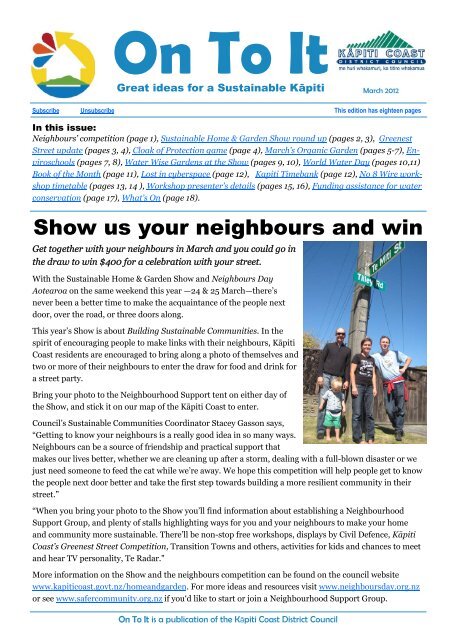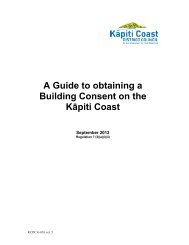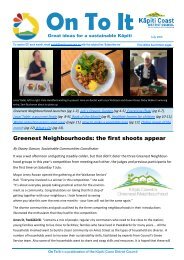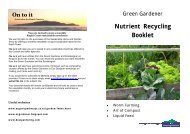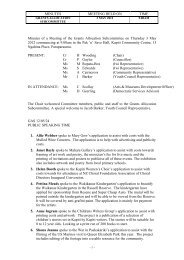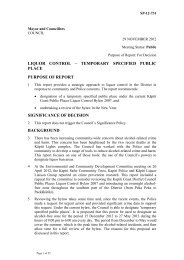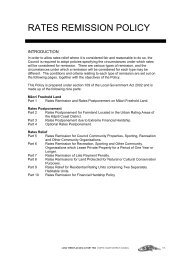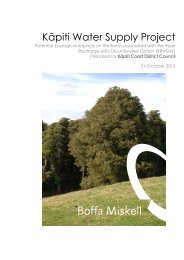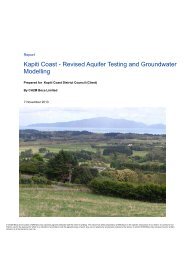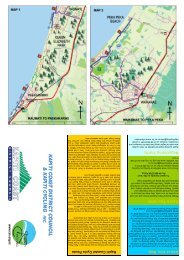March - Kapiti Coast District Council
March - Kapiti Coast District Council
March - Kapiti Coast District Council
Create successful ePaper yourself
Turn your PDF publications into a flip-book with our unique Google optimized e-Paper software.
On To It<br />
Great ideas for a Sustainable Kāpiti <strong>March</strong> 2012<br />
Subscribe Unsubscribe This edition has eighteen pages<br />
In this issue:<br />
Neighbours’ competition (page 1), Sustainable Home & Garden Show round up (pages 2, 3), Greenest<br />
Street update (pages 3, 4), Cloak of Protection game (page 4), <strong>March</strong>’s Organic Garden (pages 5-7), Enviroschools<br />
(pages 7, 8), Water Wise Gardens at the Show (pages 9, 10), World Water Day (pages 10,11)<br />
Book of the Month (page 11), Lost in cyberspace (page 12), <strong>Kapiti</strong> Timebank (page 12), No 8 Wire workshop<br />
timetable (pages 13, 14 ), Workshop presenter’s details (pages 15, 16), Funding assistance for water<br />
conservation (page 17), What’s On (page 18).<br />
Show us your neighbours and win<br />
Get together with your neighbours in <strong>March</strong> and you could go in<br />
the draw to win $400 for a celebration with your street.<br />
With the Sustainable Home & Garden Show and Neighbours Day<br />
Aotearoa on the same weekend this year —24 & 25 <strong>March</strong>—there’s<br />
never been a better time to make the acquaintance of the people next<br />
door, over the road, or three doors along.<br />
This year’s Show is about Building Sustainable Communities. In the<br />
spirit of encouraging people to make links with their neighbours, Kāpiti<br />
<strong>Coast</strong> residents are encouraged to bring along a photo of themselves and<br />
two or more of their neighbours to enter the draw for food and drink for<br />
a street party.<br />
Bring your photo to the Neighbourhood Support tent on either day of<br />
the Show, and stick it on our map of the Kāpiti <strong>Coast</strong> to enter.<br />
<strong>Council</strong>’s Sustainable Communities Coordinator Stacey Gasson says,<br />
“Getting to know your neighbours is a really good idea in so many ways.<br />
Neighbours can be a source of friendship and practical support that<br />
makes our lives better, whether we are cleaning up after a storm, dealing with a full-blown disaster or we<br />
just need someone to feed the cat while we’re away. We hope this competition will help people get to know<br />
the people next door better and take the first step towards building a more resilient community in their<br />
street.”<br />
“When you bring your photo to the Show you’ll find information about establishing a Neighbourhood<br />
Support Group, and plenty of stalls highlighting ways for you and your neighbours to make your home<br />
and community more sustainable. There’ll be non-stop free workshops, displays by Civil Defence, Kāpiti<br />
<strong>Coast</strong>’s Greenest Street Competition, Transition Towns and others, activities for kids and chances to meet<br />
and hear TV personality, Te Radar."<br />
More information on the Show and the neighbours competition can be found on the council website<br />
www.kapiticoast.govt.nz/homeandgarden. For more ideas and resources visit www.neighboursday.org.nz<br />
or see www.safercommunity.org.nz if you‘d like to start or join a Neighbourhood Support Group.<br />
On To It is a publication of the Kāpiti <strong>Coast</strong> <strong>District</strong> <strong>Council</strong>
See you at the Show<br />
By Stacey Gasson, Sustainable Communities Coordinator<br />
On To It is a publication of the Kāpiti <strong>Coast</strong> <strong>District</strong> <strong>Council</strong><br />
Page 2<br />
Come and be inspired at the Sustainable Home and Garden Show on 24/25 <strong>March</strong>!<br />
With over seventy eco-themed vendors and a range of displays by the Green<br />
Ribbon Award-winning <strong>Council</strong>, visitors are advised to bring a large bag, notebook,<br />
and plenty of time.<br />
Popular TV presenter and sustainable lifestyle enthusiast, Te Radar, will be<br />
speaking in the ‘No. 8 Wire Workshops’ tent and on the main stage on both days of<br />
the Show. He’ll also be judging the ‘Water Wise Garden’ and ‘Recycled Garden Art’<br />
competitions for schools and preschools.<br />
“The school gardens will be show-stoppers”, says <strong>Council</strong>’s Green Gardener, Hannah Zwartz. “Visitors will<br />
see five unique and dynamic gardens that showcase growing vegetables, fruit and flowers in ways that save<br />
water and are suited to local conditions.”<br />
And in the ‘potentially surreal’ section, Te Radar will be judging the ‘Te Radar Lookalike’ competition –<br />
fashion in a field, anyone? Judging will take place at 12.30pm on Sunday, so all budding Te Radar-ettes—<br />
male or female, young or older— should head over to the stage<br />
area in their best flannel shirt to flatter the judge. The winner<br />
will take away a copy of Dr Seuss’ book, ‘The Lorax’.<br />
In addition to live music and healthy food, there’ll be storytelling<br />
in the Green Gardener tepee (including Te Radar telling<br />
the Lorax story at 2.45 pm on Sunday), Enviroschools’ activities<br />
and a Treasure Hunt to keep the younger members busy while<br />
grown-ups decide which of the free talks they don’t want to miss.<br />
Beekeeping, poultry-raising, seed-saving, cheese-making,<br />
natural burials, home-grown herb teas and liquid fertilizer from<br />
noxious weeds are just some of the topics on offer. A full<br />
workshop programme can be found on the <strong>Council</strong> website.<br />
The Show is on 24/25 <strong>March</strong> at <strong>Kapiti</strong> Primary School, Rimu<br />
Road, Paraparaumu. Gates are open 9am to 4pm on Saturday<br />
and 10am to 4pm on Sunday. Entry by gold coin. For more<br />
information: www.kapiticoast.govt.nz<br />
Raumati South School students potting-up in<br />
preparation for the Show.<br />
Return to contents
On To It is a publication of the Kāpiti <strong>Coast</strong> <strong>District</strong> <strong>Council</strong><br />
Page 3<br />
2011 Clockwise:<br />
Greenest Street participants<br />
Terena and<br />
Bobby and judge Liana;<br />
Rongoa Maori<br />
garden; Green Gardener<br />
Hannah & her<br />
Carbon Corner; a<br />
Green Gardener garden<br />
in a recycled PET<br />
bottle hothouse<br />
Meet the Greenest Streets<br />
By Stacey Gasson, Sustainable Communities Coordinator<br />
The three streets participating in <strong>Kapiti</strong> <strong>Coast</strong>’s Greenest Street 2011/12 competition will be at<br />
the Sustainable Home and Garden Show. Alexander Road of Raumati Beach, Grange Park Ave<br />
from Raumati South and Wellington Road of Paekākāriki will be sharing a marquee to<br />
showcase their exploits and share some of their skills with Show attendees.<br />
Many of the participants will be meeting the other streets for the first time, so they’ll no doubt have plenty<br />
to talk about. Judges Robert Glensor, Liana Stupples and Brenda Vale will also be dropping by for a catchup<br />
over the weekend.<br />
So far I understand Grange Park Ave will be sharing their eco-cleaner recipes and demonstrating food<br />
drying. Wellington Road will be sharing the details of their ‘Project Rat Pack’ (complete with a great wee<br />
resource they can email you). Looking at their blog, I see they’ve trapped 28 rats to date—an impressive<br />
haul and well-worth the effort!<br />
Alexander Road have decided that if they’re going to be building more bio-digesters to liquefy their<br />
noxious weeds, why not share their know-how? Bio-digester building demonstrations will be held at 2.15<br />
pm on Saturday and 3.00pm on Sunday in the Green Gardener’s space. And I hear there’ll be an interesting<br />
presentation of some of Diane’s haul from her three Sea Week beach cleans.<br />
Return to contents
To find out more about happenings in the streets, listen to the regular Greenest Street slot on Beach FM.<br />
We’ll have a round-up of news about the streets at the Show on 3 April.<br />
For more information about the competition can be found at www.kapiticoast.govt.nz/greenest-street.<br />
Or contact the Sustainable Communities Coordinator on 04 296 4700.<br />
Weave me a cloak of feathers...<br />
On To It is a publication of the Kāpiti <strong>Coast</strong> <strong>District</strong> <strong>Council</strong><br />
Page 4<br />
After “years of stubbornness” (nine to be exact), it<br />
looks like first-game designer, Jil Hemmings, has a<br />
talent. Starting from the simple desire to “do<br />
something on birds”, Jil came to understand the role<br />
predators have played in the demise of New Zealand’s<br />
native inhabitants and created a card game.<br />
‘Cloak of Protection’ recalls the history of Aotearoa/<br />
New Zealand as a land of birds, their feathers<br />
creating a great cloak over land, sky and sea. Players<br />
are introduced to the predators, hungry mammals, and must weave a new feather Cloak of Protection in<br />
one of the four realms (forest, sea, settlement, extinct).<br />
Looking for a word to describe the game, I keep returning to “rich” - from the art quality imagery, to the<br />
four realms complete with gods, the strategic play, the image of making and breaking our world, and the<br />
supporting information booklet. Jil has previously written fiction for TV and newspaper and it shows in<br />
the depth she’s built into the game.<br />
Jil explains that games are normally based on the ‘heroic’ model, but in this case play is founded on a base<br />
of strategy, cooperation and trading. Winners are those who are alert and aware of what’s happening<br />
around them. It’s a model that has demonstrated its appeal to the students Jil has taught to play— in some<br />
cases, they’re still playing a day later when she’s gone back.<br />
The information about the predators was provided by John Innes of Landcare Research. He also wrote the<br />
accompanying booklet and Jil suspects his colleagues tested the game for her in their lunch breaks,<br />
providing useful feedback. The game itself is a work in progress—discussion on the website may influence<br />
a future reprint, and Jil is keen to include lizards alongside the birds, reflecting this other element of<br />
Aotearoa’s native fauna.<br />
The airbrushed images—actual and mythological—were created by Morgan Rothwell, a local artist<br />
specialising in wildlife and fantasy images. Jil describes him as an illustrator with a love of skeletons,<br />
telling me she spent eight months driving around with him and an ever-present plastic bag, just in case<br />
they came across something interesting to pick up off the road. He then created the images in an intensive<br />
two-week burst, resulting in a series of portraits she describes as having been envisaged from the inside<br />
out.<br />
Now armed with a game that has turned out ‘better than I imagined’, Jil will be spending this year<br />
marketing it. She says she’ll go anywhere to play it and can be contacted through her website—<br />
www.kakarikigames.co.nz. The game is also for sale via the website or a range of retailers including<br />
Mahara Gallery, Nga Manu Bird Sanctuary, Zealandia and Pataka Museum of Arts and Culture.<br />
Or you can see the game being played at the Sustainable Home and Garden Show.<br />
Return to contents
<strong>March</strong> and ahead in the Organic Garden<br />
By Hannah Zwartz, Green Gardener<br />
IT’S SHOWTIME ! I’m getting excited about the Green Garden, which for this Show<br />
will include a kids’ space tepee with storytellers; herbal tea garden (where I’ll be<br />
sampling fresh teas with Te Radar); hugelkultur bed (find out how to build one); a<br />
worm bath and beehive; and displays and workshops on natural pest control.<br />
Ever wondered how to tell the good insects from the pests? Or read about hoverflies<br />
but wondered what they actually look like? Find out how to encourage the good guys into your backyard,<br />
at the Green Garden. (We’re extending the show’s theme of ‘Building Sustainable Communities’ into the<br />
insect world.)<br />
And if you’ve been thinking about getting a rain tank or greywater<br />
system to make better use of water in your garden, the Show is<br />
the perfect one-stop shop to see all the different sizes, shapes and<br />
prices. Find out more about the <strong>Council</strong>’s funding scheme to help<br />
ratepayers install these systems, up to the value of $5,000; it’s all<br />
at the Show.<br />
Late Summer Jobs:<br />
• Beat the late summer garden blues with a big clean out,<br />
emptying beds of non-performers, piling up spent calendula,<br />
lettuces and the like on the compost heap, with<br />
manure and seaweed, for next spring’s compost.<br />
• Save seeds of lettuce, calendula, silver beet etc. as they dry<br />
out. Find out more at Anna Butterfield’s Seed Saving<br />
workshop at the Show (see program on page 13).<br />
• Plan your winter garden, preparing beds for garlic, leeks, Death and decay have an up-side: mulch new plant-<br />
winter greens, brassicas, carrots, beetroot, green manure ings with your old compost, to make room on the<br />
crops. Find out more about seasonal crops at Cree<br />
heap for an autumn clean-out.<br />
Hatfield’s Urban Productive Garden workshop at the Show (see program page 13).<br />
• Dig in any green crops (this could include areas of borage or calendula) and add manure and<br />
compost for brassicas or leeks - but not for root crops. If growing from seed, sow them now to be<br />
ready for planting out in about 3 weeks.<br />
• Root crops, like carrots and beetroot, grow well over winter. They need good soil but not extra<br />
compost. Sow direct and keep moist, thinning after about one month and then at two months old.<br />
• Pest patrol: Pests are out in full force, breeding like aphids in the autumn conditions. Use digital<br />
control (finger and thumb) to squash green shield bugs and looper caterpillars. Spray brassicas with<br />
organic Bt spray, or cover with nets, to stop white butterfly damage. Find out more at Natural Pest<br />
Control workshops at the Show (see program on page 14).<br />
• Add liquid feed, like seaweed concentrate, to your watering can, especially for plants that are<br />
fruiting. Keep watering feijoas and citrus to fatten their fruits. Keep bags in the car for seaweed<br />
collecting.<br />
• If your own garden isn’t producing, go foraging for wild foods. Find out more from Steve Porteous’<br />
Wild Food Walk at the Show (see program on page 14).<br />
On To It is a publication of the Kāpiti <strong>Coast</strong> <strong>District</strong> <strong>Council</strong><br />
Page 5<br />
Return to contents
Plant: Brassicas, silver beet, lettuce and other salad greens, red onions, leeks.<br />
Sow: Carrots, beetroot, coriander, rocket, calendula, peas, green crops (direct); alyssum, lettuce, spinach,<br />
silver beet, peas (in trays). Also kale, broccoli, cabbage, cauliflower (in trays, protected from white<br />
butterflies.)<br />
Broccoli grown by my Paekakariki<br />
neighbour, ace gardener Joanne<br />
Morgan.<br />
Spotlight on brassicas: kale, cabbage, cauliflower,<br />
broccoli and mustard.<br />
• They love lots of good compost and seaweed. Add plenty of<br />
nitrogen (eg. manure) for leafy cabbages and kale, with extra potassium<br />
(eg. wood ash) for `headers’ like caulis and broccoli.<br />
On To It is a publication of the Kāpiti <strong>Coast</strong> <strong>District</strong> <strong>Council</strong><br />
Page 6<br />
• Plant a variety, for different harvesting times – you may not be<br />
picking sprouting broccoli until spring, but you’ll be glad of it then.<br />
Purple frilled kale, or purple cauliflowers add some colour to the bed.<br />
If you’re not growing from seed, the newspaper parcels at the supermarket<br />
are good value, but don’t leave them sitting round - get the bed<br />
ready first, then buy them.<br />
• Sometimes it’s hard to find space for the winter crops when<br />
summer ones are still growing, but getting in brassicas early (<strong>March</strong> at<br />
the latest) is crucial if they’re not to stay accusingly small all winter.<br />
Make new beds if needs be.<br />
• Plant seedlings lower than they were in punnets, firming them in<br />
`up to their necks’ (ie. right up to the lowest set of `leaves’ - actually the seed leaves or cotyledons.)<br />
This reduces wind rock, a common reason for crop failure - it’s hard to grow big when you’re being<br />
shaken back and forth by every gust. Compost can also be piled up around brassica stems as they<br />
grow.<br />
• Water in each seedling with a cup of liquid feed (seaweed or manure tea). Keep watered in dry spells.<br />
• Protect cabbage from white butterflies and their green caterpillars using netting or a bT spray. bT is<br />
an organic bacterial spray that interferes with caterpillars appetites, starving them to death without<br />
affecting other insects. Derris Dust, formerly organically approved, has now been linked to nerve<br />
damage and Parkinson’s disease.<br />
• Mustard is a great, easy cover crop over winter. It can be broadcast-sown (sown directly onto beds) in<br />
autumn; young leaves are picked for salads (delicious with something sweet, like grapes, and a<br />
squeeze of lime juice); older leaves can be cooked in stir-fries or boil ups and any leftover leaves and<br />
stems can be dug in as green manure or put on the compost heap.<br />
Mustard is rich in sulphur, a natural steriliser, so it’s good to grow where<br />
you’ve had disease problems.<br />
Companion Gardeners<br />
Every second Tuesday morning Companion Gardeners meet to do some<br />
weeding, pruning or planting and share seeds and skills - not to mention the<br />
coffee, talk and baking. “It’s sociable, enjoyable and we get work done,” says<br />
organiser Jill Duncan.<br />
There are anywhere between four to a dozen people each time, alongside<br />
children and babies. From working only in each others’ gardens, the group<br />
want to move on to having monthly get-togethers at other people’s gardens,<br />
Good Companions: gardener Jill<br />
Duncan and friends.<br />
Return to contents
says Jill - maybe elderly people who are finding it hard to keep up with their garden, or others who need a<br />
hand.<br />
Companion Gardeners started in 2010 through Raumati’s Te Ra Waldorf School (a centre for biodynamic<br />
gardening) aiming to link people needing some inspiration, who’d maybe tried gardening without a lot of<br />
success with those with skills and resources to share with others. It’s open to anyone interested in organic<br />
gardening, says Jill. If you are interested please call her on 902-2851 or email<br />
jill.duncan@paradise.net.nz.<br />
The <strong>Council</strong> Green Gardener, Hannah Zwartz, offers sustainable and waterwise gardening advice to<br />
local residents, community groups and schools.<br />
Community Visits are free. Get together five friends or neighbours and invite the Green Gardener<br />
round.<br />
Workshops: Formal 2-hour workshops cost $50 (you can charge participants).<br />
To contact the Green Gardener, call the <strong>Council</strong> on 04-296 4700 or 0800 486 486, or see<br />
www.kapiticoast.govt.nz/greenservices<br />
Enviroschools at the Show<br />
By Nicola Easthope, Kāpiti Enviroschools Facilitator<br />
Kāpiti enviroschools are once again enthusiastically involved in the Kāpiti Sustainable<br />
Home and Garden Show. As well as participating in the <strong>Council</strong>’s sustainable<br />
garden and garden art competitions, the<br />
schools and preschools will be busy in the<br />
Enviroschools tent.<br />
Saturday 24 th :<br />
9am-11am - Raumati South School—displaying their weta hotels.<br />
11am-1pm - Little Earth Montessori Preschool—hosting an interactive<br />
activity, where children can make coffee ground fossils! Check<br />
out Principal Anja Geelen’s blog here.<br />
1pm-2.30pm - Raumati South Kindergarten—selling bird feeders<br />
made from pinecones, worm wee fertiliser, and swan plant seedlings<br />
planted in tins painted by the children.<br />
From 2.30-3.00pm, Te Radar will be in the tent as a one-man<br />
‘panel’, fielding questions from student envirogroups about<br />
sustainable living.<br />
Sunday 25 th :<br />
On To It is a publication of the Kāpiti <strong>Coast</strong> <strong>District</strong> <strong>Council</strong><br />
Otaki School making cards<br />
10am-1pm - Paraparaumu Playcentre (tbc)<br />
Paraparaumu Playcentre potting up.<br />
1pm-3pm - Waikanae Kindergarten—sharing a display of their<br />
enviro-journey, and offering an interactive sand tray for children to make their own art or garden. They<br />
will also be selling insect homes, potted seedlings, succulents, and white butterfly protectors.<br />
And more! More plans are in progress… come along to the Enviroschools tent, find out about the<br />
Enviroschools programme and be part of the fun.<br />
Page 7<br />
Return to contents
Waikanae children get creative at Mahara Gallery<br />
By Nicola Easthope, Kāpiti Enviroschools Facilitator<br />
In one gallery, a boy gazes at a finely lined landscape and wonders how the artist did it; in another, two<br />
girls puzzle over five paintings of a yellow jersey, suddenly excited as they share a ‘eureka’ moment. In the<br />
corner of the gallery, a group of children huddle around a small table, swapping cards in an effort to<br />
prevent native birds from becoming extinct.<br />
The creative juices are flowing for pupils of Kapanui and Waikanae<br />
schools, who have begun their school year engaged in a ‘Native Habitats’<br />
project at Mahara Gallery. Using the gallery’s three current exhibitions<br />
and a unique card game as inspiration, the Year 5 and 6 students are<br />
writing poetry and creating artworks around local nature, extinction and<br />
conservation themes. One 9 year old boy thinks it’s so amazing, he brings<br />
his mother in the following day, pulling her around from painting to<br />
woodcut and back again: “Look Mum, here are the gods and goddesses!”<br />
Ten-year old Callum Edwards, who likes drawing, chooses a painting from<br />
Barbara Strathdee’s Waikanae Stills: “It really interests me because of the<br />
shapes and colours. In the background, there is <strong>Kapiti</strong> Island; in front<br />
there is the dark water and then the sand.” After brainstorming five ideas,<br />
which together read like a poem in itself, ten-year old Isaac Kerschbaumer<br />
begins his piece, “The cycle of life goes quickly round…”<br />
On To It is a publication of the Kāpiti <strong>Coast</strong> <strong>District</strong> <strong>Council</strong><br />
Page 8<br />
Janet Bayly, Mahara Gallery Director explains, “We aim to show all the<br />
Goodman discussing painting.<br />
artwork and poetry the children produce, and a small number will be given<br />
awards and published in a book. The Native Habitats: Waikanae Children’s Creations exhibition will run<br />
alongside our annual Mahara Arts Review. These works will then be gifted to Nga Manu Wildlife Centre<br />
for display in their new education suite”.<br />
Meanwhile, the children are quickly becoming adept at playing<br />
the ‘Cloak of Protection’ card game. Created by local artist Jil<br />
Hemming, and illustrated by Morgan Rothwell, the unique<br />
game, while competitive, requires cooperation between players<br />
to save New Zealand’s endangered birdlife. Nga Manu will host a<br />
game play-off between the two schools in a few weeks.<br />
The Native Habitats schools programme is sponsored by the<br />
Philipp Family Foundation, which also funded the new education<br />
centre established at Nga Manu last year. Founder, Robin<br />
Philipp, is in the gallery during one of the class workshops: “I am<br />
delighted to see children engaged actively in this project. Their<br />
Jazmyn Ward, Ioana Mihaila & Callum<br />
enthusiasm is really palpable. We set up the fund to help foster<br />
Edwards.<br />
greater awareness of the interaction between the external<br />
environment and the internal physiological environment within ourselves. My father always said<br />
“Everything in life is connected.” Bringing together the arts and conservation at Mahara and Nga Manu is<br />
an opportunity I feel privileged to support.”<br />
*************************<br />
Marcus Flattery-Donohoe & Charlie<br />
Mahara exhibitions: Native Habitats: Waikanae Children’s Creations and The Mahara Arts Review – 6 May-1 July.<br />
The book of children’s work will be launched on 15 June.<br />
Return to contents
By Anne Brunt, Water Education Advisor<br />
On To It is a publication of the Kāpiti <strong>Coast</strong> <strong>District</strong> <strong>Council</strong><br />
Page 9<br />
Young people lead the way with Water Wise gardens<br />
The Water Wise Garden Competition for schools and early childhood<br />
centres will be at the Sustainable Home & Garden Show again this year<br />
with five entries. The <strong>Council</strong>’s Green Gardener, Hannah Zwartz, says<br />
“These gardens will be show-stoppers. Visitors will see five quite different<br />
gardens that showcase growing vegetables, fruit and flowers in<br />
ways that save water and are suited to local conditions. All the groups<br />
have been given two rain barrels as a water source, but each garden is<br />
unique and dynamic.”<br />
Raumati South School teacher, Michael Stewart, says students from<br />
across the school are involved in creating a garden entitled ‘Our Backyard’.<br />
“It is a garden that people can take with them if they move and<br />
reflects the fact that many of us have gardens that back onto the beach.<br />
It’s a bright, colourful and fun garden.”<br />
Susan Barrett from Ōtaki Kindergarten says their garden is called<br />
‘Sustainable Cycles’ and will focus on their school garden. “Our children<br />
experience seasonal growing cycles for vegetables, fruit and flowers<br />
and learn about recycling of materials wherever possible. Our<br />
school garden creates habitats for birds and bees and our show garden<br />
will include a bee café. Our children are delighted that our chicken will<br />
have an outing to the show too!”<br />
Paraparaumu Playcentre’s garden will demonstrate the guiding principles<br />
of early childhood education. Spokeswoman, Kylie Van Dyke, says<br />
the garden will focus on the hauora or wellbeing of all living things.<br />
“The garden will have four sections representing wellbeing, belonging,<br />
contribution and exploration.”<br />
Year 10 Horticulture students at Paraparaumu College are creating a<br />
vibrant flower and native plant garden that anyone who lives near the<br />
beach could establish. It will feature artworks created from material<br />
collected from the beach and will use natural mulches. A water feature<br />
created from unused items at the college will be solar powered.<br />
<strong>Kapiti</strong> College special needs students and staff are creating a sensory<br />
garden that teacher Keri Holmes says promotes tranquillity and hauora<br />
(wellbeing). “Visitors will have the opportunity to consider how each of<br />
our senses are engaged when we appreciate a garden.”<br />
“The garden will provide tactile experiences with the opportunity to feel<br />
plants with different textures. There will be plants with a range of<br />
scents. Planting that focuses on patches of colour will encourage reflection<br />
on how what we see influences how we feel. Plants can be picked<br />
and tasted in the garden, which will feature the sound of running water.”<br />
Photos top to bottom: Preparing for the Show—Paraparaumu Horticulture students;<br />
Raumati South School; <strong>Kapiti</strong> College Special Needs Unit; Paraparaumu Playcentre.<br />
Return to contents
By Anne Brunt, Water Education Advisor<br />
On To It is a publication of the Kāpiti <strong>Coast</strong> <strong>District</strong> <strong>Council</strong><br />
Page 10<br />
<strong>March</strong> 22 is International World Water Day. The day is organised by the United Nations each year to focus<br />
attention on the importance of freshwater.<br />
There's a whole lot of water on Earth, roughly 1,260,000,000,000,000,000,000 litres (12,60 million<br />
trillion litres), but only a small amount is freshwater available for plants and animals to use.<br />
Ninety eight percent of the water on the planet is in the<br />
oceans, and therefore currently undrinkable because of the<br />
salt. About two percent of the planet's water is fresh, but<br />
eighty percent of this freshwater is locked up in the polar ice<br />
caps and glaciers or underground in aquifers and wells.<br />
Less than half a per cent of the planet's total water supply is<br />
found in lakes and rivers and is available for all of us to use.<br />
The rest of the water on the planet is either floating in the air<br />
as clouds and water vapor, or is locked up in plants and<br />
animals. There's also all the liquids (soft drinks, milk and juice) and the food that contains water that you<br />
see at the shop and in your refrigerator.<br />
These figures can be hard to absorb, so you might like to do this activity with your family:<br />
• Collect two buckets of water or 20 litres of water in milk containers. This represents all the water on<br />
Earth.<br />
• Pour two mugs of water from the 20 litre container into a bowl. The water left in the container<br />
represents how much of the world’s water is ocean and salty water. The two mugs represent the<br />
world’s fresh water.<br />
• Pour half the contents of one mug into a cup. The water left in the one and a half mugs represents<br />
that which is locked up in the Arctic and Antarctica.<br />
• From the cup, take out three teaspoons of water and keep it safe! It represents the less-than one<br />
percent of the world’s water that is fresh and can be easily reached in lakes, rivers, the soil, plants<br />
and animals.<br />
• The water left in the cup represents the fresh water that is underground and can’t be reached.<br />
As the world population increases there is increasing pressure to use our finite supply of freshwater.<br />
People in different parts of the world use different amounts of water.<br />
Return to contents
Food security - the theme for World Water Day 2012<br />
On To It is a publication of the Kāpiti <strong>Coast</strong> <strong>District</strong> <strong>Council</strong><br />
Page 11<br />
The world is thirsty because of our need for food. This year<br />
the focus of World Water Day is food security. Each of us<br />
needs to drink 2 to 4 litres of water per day. But it takes<br />
2,000 to 5,000 litres to produce food for one person in the<br />
developed world for a day.<br />
Today’s world population is over 7 billion and is expected to<br />
reach 9 billion by 2050. To feed everyone we need to secure<br />
adequate good quality water supplies.<br />
To investigate world food security issues visit the United Nations website and view the brochure and the<br />
frequently asked questions.<br />
Safe drinking water here on the Kāpiti <strong>Coast</strong><br />
Many of us drink a cool refreshing glass of tap water without [giving a thought to where it came from and<br />
why it is safe to drink.<br />
On World Water Day a 12 minute DVD ‘Our Safe Drinking<br />
Water’, will be linked from Youtube to the <strong>Council</strong>’s Website.<br />
The DVD describes how water taken from streams and bores on<br />
the Kāpiti <strong>Coast</strong> is treated and delivered to your taps. It explains<br />
why you can drink that glass of water with confidence, knowing<br />
that the water is of good quality and safe to drink.<br />
The DVD segment is part of a longer DVD developed for use in<br />
schools and shows students from Paekakariki School visiting the<br />
Waikanae Water Treatment Station. Copies of the longer DVD can be borrowed from local libraries.<br />
Book of the<br />
month<br />
Green guide for artists: non-toxic recipes, green art ideas &<br />
resources for the eco-conscious artist. By Karen Michel, 2009.<br />
The author, motivated by her concern to safeguard health, home<br />
and the wider environment, relays the growth in her awareness of<br />
how to make sound product choices. Her guide to choosing paints,<br />
adhesives, paper, canvas and recipes for paints, dyes and binders<br />
is a work of art itself in its layout and illustrations. One chapter<br />
describes projects with collage, papier mache, beads, bookmaking<br />
photographs, found objects and sewing. Chapter four, “Artists’<br />
gallery” by Kristen Hampshire describes and illustrates the works<br />
of accomplished artists who use a wide range of media.<br />
The resources listed at the back are mainly in the northern<br />
hemisphere however there are bound to be ideas for downunder<br />
artists, young and experienced.<br />
Return to contents
This month's pick of sustainability on the internet<br />
On To It is a publication of the Kāpiti <strong>Coast</strong> <strong>District</strong> <strong>Council</strong><br />
Page 12<br />
Going green—12 simple steps for 2012—the Worldwatch Institute brings you ecoresolutions<br />
for the new year. There’ll be nothing new here for you converted<br />
greenies, but a reminder’s always good and it’s a nice summary of the issues and<br />
practical actions.<br />
Inspiration—www.projectlitefoot.org—Project Litefoot is a charitable trust fronted by seven of New Zealand’s<br />
top sportspeople, seeking to lead by example and inspire New Zealander’s to make simple lifestyle<br />
changes to reduce their environmental impact. Aware of the pulling-power that high-profile sportspeople<br />
carry, PL targets sports and business communities to collectively reduce the nation’s greenhouse gas emissions<br />
by 1 million tonnes. Environmental action is simplified and reframed as a fun way to free up resources<br />
for sport, communities and future generations.<br />
Food —Lyttleton’s Honest Cooks - a profile of a really interesting project. Wanting to “create the future<br />
they want to see” this group are working towards a sustainable restaurant. In the meantime they offer local<br />
food parties and a supper club with all food made from scratch using local ingredients.<br />
Design—http://www.whiteroofs.org.nz/ - White Roofs is a simple idea offering one of the fastest and lowest<br />
cost ways of helping reduce global warming by mimicking how the polar icecaps reflect sunlight back<br />
into space and cool the planet. White roofs have been used in the Mediterranean and the Middle East for<br />
thousands of years to cool buildings, and more recently to improve energy efficiency by reducing the need<br />
for air conditioning. The White Roofs Project NZ want to start an 18-month campaign promoting this idea<br />
here—find out more from their website.<br />
Keep Your Eye on the Timebank<br />
Ever needed some clothing altered, or to revive a crashed computer, get some gardening<br />
help, learn some language for travel or fix a leaky tap - and suspected there were<br />
probably people on your street with the skills to help you easily?<br />
You need to know about Timebanking. Timebanking harnesses the wonders of online<br />
social networking to help communities share skills. Each member can offer or request services - be they<br />
cleaning, carpentry, gardening or piano lessons - in exchange for time credits instead of money. These<br />
credits can then ‘buy' another member’s time and skill - and everyone’s time is of equal value. I can earn<br />
an hour’s credit gardening for Joe, and then spend it getting my haircut by Susan.<br />
Timebanking is a non-profit, grassroots initiative committed to building sustainable, connected communities.<br />
Timebanks are major assets to communities in the face of natural and economic crises - Lyttleton<br />
Timebank was instrumental in the Christchurch earthquake recovery. What’s more, each exchange contributes<br />
to building community interdependence, the free exchange of local knowledge, facilitating integration<br />
for newcomers, and intergenerational networks.<br />
<strong>Kapiti</strong> Timebank exists within a growing, thriving network of Timebanks nationally and internationally.<br />
Join our Facebook group ‘<strong>Kapiti</strong> Timebank’ to keep up to date and learn more - and look out for us at the<br />
SHAG show 24/25 <strong>March</strong>!<br />
Return to contents
On To It is a publication of the Kāpiti <strong>Coast</strong> <strong>District</strong> <strong>Council</strong><br />
Page 13<br />
Return to contents
On To It is a publication of the Kāpiti <strong>Coast</strong> <strong>District</strong> <strong>Council</strong>
Who’s that up the front?<br />
The speakers at this year’s Sustainable Home & Garden<br />
Show are a talented lot with a wealth of experience to<br />
share.<br />
Alexis Murti & Mindi Clews – Cheesemaking<br />
Mindi and Alexis are<br />
keen home cheesemakers<br />
and regularly teach<br />
both cheesemaking and<br />
cooking classes<br />
throughout the lower North Island.<br />
www.curiouscook.co.nz<br />
Andrew Beach - Beekeeping<br />
Andrew has been keeping bees<br />
for over 50 years - 25 of them<br />
in New Zealand. He has been<br />
the Chairman of the Wellington<br />
Beekeeper’s Association, is a beekeeper, works<br />
part-time for AsureQuality, and is setting up a beekeeping<br />
club in <strong>Kapiti</strong>.<br />
www.kapitibeesandwasps.co.nz<br />
Anna Butterfield—Seed Saving<br />
Anna is an edible gardener, seed grower and food fanatic.<br />
She is the instigator of the popular Seedy Sunday<br />
events in <strong>Kapiti</strong>. In her spare time she researches and<br />
writes about plant varieties and gardening techniques.<br />
www.loveplantlife.com<br />
Clyde Lambourn – Solar Cooking & Cookers<br />
Clyde grew up on a small<br />
farm and so has a wide<br />
range of practical DIY<br />
skills. He spent 25 years<br />
as an Electronics Technician,<br />
then changed<br />
track in 1990 to take up<br />
his present occupation<br />
as a House Renovator and Maintenance Person.<br />
In 1992 he became a founder member of the Appropriate<br />
Technology for Living Association (ATLA), to learn<br />
about and disseminate strategies for 'alternative technology',<br />
and 'low impact' living.<br />
See Clyde at the ‘Sunplugged Solar Cookers’ stall at the<br />
Show.<br />
Cree Hatfield - Productive Urban Gardening<br />
Cree has been gardening organically for over thirty<br />
years and lives in Raumati South, where she grows<br />
most of her household’s fruit<br />
and vegetables. She is a garden<br />
coach and co-ordinator of Raumati<br />
South’s MOA community<br />
orchard. Her interests include<br />
permaculture, biodynamics and<br />
backyard beekeeping.<br />
On To It is a publication of the Kāpiti <strong>Coast</strong> <strong>District</strong> <strong>Council</strong><br />
Darcy Philp - The Art & Science of Backyard Poultry<br />
Keeping<br />
Page 15<br />
Darcy has been a presenter on the ‘Funky<br />
Chicken Farm’ programme with Simon<br />
Morton on National Radio. He has over 50<br />
years involvement with poultry breeding,<br />
exhibiting and judging. He is the current<br />
president of the Wellington, Hutt Valley &<br />
<strong>District</strong>s Poultry & Pigeon Club, and was the president<br />
of the North Island (NZ) Poultry & Pigeon Association<br />
for 12 years.<br />
He has bred a wide range of poultry: Australorps, Orpingtons,<br />
Barred Plymouth Rocks, Rhode Island Reds,<br />
Minorcas, Leghorns and Silkies.<br />
Bantams – Pekins, Australorps, Leghorns, Rosecombs,<br />
Rhode Island Red, Wyandotte.<br />
Modern Game Ducks – Pekin, Cayuga, Indian Runner,<br />
Rouen, Welsh Harlequins.<br />
Jenny Lindberg—Native Parenting<br />
Jenny is a sacred birthing midwife<br />
and absolute advocate of natural<br />
birth. She has had two beautiful<br />
homebirths and is strongly modeling<br />
native parenting by living it fully with<br />
her family.<br />
www.human.org.nz<br />
Julia Milne—Low Cost Gardening<br />
Working with the ‘Great Start’ gardening programme<br />
in Taita, Julia discovered locals lacked tools, seeds and<br />
expertise to get gardening. With little money but a lot<br />
of imagination Julia has shown what can be done—<br />
including a glasshouse made of plastic bottles and the<br />
screens from pokie machines, a seed bank and a tool<br />
lending library.<br />
Natasha & Nico Robertson, Emily Williams—<br />
Cooperatives<br />
Tash, Nico and Emily are all active members of thriving<br />
organic food cooperatives. Tash & Nico house a cooperative<br />
in Raumati South, which now has about 80<br />
Return to contents
members.<br />
Nicky Craig – Naturally Fermented Sourdough & Ginger<br />
Beer<br />
You may remember Nicky from<br />
her columns in On To It. She<br />
lives at the Pukeko Plot in Te<br />
Horo beach with her partner and<br />
two children. They love good<br />
food and so grow and make as much as they can.<br />
Renee Gerlich, Ben McHugo & others – Timebanking<br />
Ben is a Manakau resident,<br />
passionate about community,<br />
and the current chairman of Ōtaki Timebank.<br />
Renee is from Paraparaumu and part of the <strong>Kapiti</strong><br />
Timebank, which is a group of people keen to build and<br />
strengthen community between Paekakariki and<br />
Paraparaumu. She works in arts and education and<br />
tutors at Victoria University.<br />
http://www.timebank.otaki.org.nz/<br />
http://www.kapiti.timebanks.org/<br />
Esther Kiernan—Reusable Nappies<br />
(replacing Sarah Hurrell)<br />
Esther has used cloth on her three kids and<br />
sewn hundreds of them for friends and<br />
family.<br />
She’s a long-time member of the Nappy<br />
Network and sells her own nappy patterns.<br />
She’s worked as a writer and editor for an educational<br />
publisher, but is kept busy homeschooling her children.<br />
She’ll be comparing disposables and cloth in terms of<br />
effort, effectiveness, cost, environmental cost, and<br />
baby-friendliness and examining the different types of<br />
reusable nappy and how to use them<br />
Shona Jaunas – Crime Prevention Through Environmental<br />
Design<br />
Shona Jaunas is the Crime Prevention Manager for the<br />
<strong>Kapiti</strong> Safer Community Trust.<br />
www.safercommunity.org.nz<br />
Simcha Delft – Tool Care and Sharpening<br />
Simcha has been a renowned<br />
luther (tool maker) for many<br />
years. Since moving to Ōtaki<br />
she has embraced the sustainable<br />
lifestyle, including being<br />
able to function nicely without power if necessary.<br />
Steve Porteous - Wild Foods Walk<br />
On To It is a publication of the Kāpiti <strong>Coast</strong> <strong>District</strong> <strong>Council</strong><br />
Page 16<br />
Steve has been eating and sharing wild edible and medicinal<br />
foods for the past 12 years. It is an integral part<br />
of his life and a valuable means of feeding his family<br />
hand in hand with their regular garden.<br />
His organisation, Human Bushcraft and Wild Living,<br />
seeks to connect people to nature through classes and<br />
activities for adults, youths, and children from<br />
bushcraft and survival skills, to wild food walks and<br />
nature awareness.<br />
www.human.org.nz<br />
Tamara Linnhoff – Sustainable Funerals<br />
Tamara and partner Andrew Hubbard run TenderRest,<br />
a Wellington-based company creating<br />
modern funeral caskets. Caskets are designed<br />
to reflect the individual – natural<br />
materials in a range of non-traditional<br />
shapes, many ornamented with prints or<br />
bespoke design options that will reflect a<br />
truly individual personality.<br />
Tamara also runs the Good Funeral Guide – an online<br />
information resource dedicated to providing information<br />
and inspiration for more personalized funerals and<br />
final celebrations of a unique life. Tamara will be available<br />
for discussions all weekend at the TenderRest casket<br />
stand.<br />
www.TenderRest.co.nz<br />
www.GoodFuneralGuide.co.nz<br />
Return to contents
Funding assistance for rainwater & greywater irrigation<br />
The <strong>Council</strong> supports the use of rainwater and greywater for outdoor irrigation.<br />
If enough households use on-site water sources for outdoor irrigation, our current supplies will meet the<br />
needs of our growing communities for years to come.<br />
On To It is a publication of the Kāpiti <strong>Coast</strong> <strong>District</strong> <strong>Council</strong><br />
Page 17<br />
The <strong>Council</strong> is offering funding assistance to residents to purchase and install on-site water supplies for<br />
outdoor irrigation. Currently <strong>Council</strong> proposes providing up to a maximum of $5,000 for a householder to<br />
purchase and install any of the options below.<br />
The following options are available:<br />
• 5,000—10,000 litre tank installed<br />
• refurbishing an older rainwater tank<br />
• greywater diversion device<br />
• install a pump on a 5,000 litre or bigger rainwater tank<br />
The <strong>Council</strong> will not fund for irrigation systems for rainwater, or water purification systems.<br />
How will the Water Saving Service work?<br />
The <strong>Council</strong> will provide funding for a household to install a device. The money will be paid back over 10<br />
years through the household’s rates. The targeted rate is set to the household not the owner. So if the<br />
household is sold and changes hands, the new home owner will continue paying the original funding back.<br />
Who pays the interest?<br />
The ratepayers will pay the interest over the ten years the household repays the funding.<br />
How much will be available to a household?<br />
The <strong>Council</strong> will provide a maximum of $5,000 including gst.<br />
The overall scheme will be capped and will be on a first applied, first approved basis.<br />
Who is eligible for the funding assistance?<br />
Anyone who lives in a home:<br />
a) built before February 2008<br />
b) that has an unrestricted water supply connection to a public supply<br />
c) has a good rate repayment history<br />
d) must be the property owner and name registered on the title<br />
Come along to the Sustainable Home and Garden Show on 24 -25 <strong>March</strong> to find out more about<br />
how <strong>Council</strong> can help you install an onsite water supply for outdoor irrigation.<br />
Return to contents
Events - What’s Coming Up?<br />
MenzShed, Tuesdays and Thursdays, 10am -<br />
12.30pm. Meet with other men at the <strong>Council</strong><br />
Depot to work on woodwork projects, socialise,<br />
share or learn some skills. Behind 24 Rangihiroa<br />
St, Waikanae Beach.<br />
Greenest Street II on Beach FM, Tuesday 3 April,<br />
11.30am. Listen to 106.3FM to catch up with the<br />
Greenest Street entrants.<br />
<strong>Council</strong>’s Green Team on Beach FM, Fridays,<br />
from 9.30am. Hear from a range of the <strong>Council</strong>’s<br />
Green Services every Friday as they update you on<br />
local sustainability initiatives, opportunities and<br />
ideas.<br />
Sustainable Home & Garden Show,<br />
24/25 <strong>March</strong>, 9am to 4pm on Saturday,<br />
10am to 4pm on Sunday. At<br />
<strong>Kapiti</strong> Primary School, Rimu Rd,<br />
Paraparaumu. Entry by gold coin,<br />
children free.<br />
Regular environmental working bees: restoration<br />
group contact details can be found here<br />
Mondays: Waitohu Stream Care Group, 9am—<br />
10.30am.<br />
Tuesdays: Greendale Reserve, Otaihanga, 9am –<br />
12.00pm; Keep Ōtaki Beautiful, 9am—12.00pm.<br />
1st and 3rd Tuesday of the month: Waimeha<br />
Lagoon & Waikanae Dune Restoration Group, 3-<br />
5pm.<br />
Wednesdays: Friends of the Ōtaki River, 9.00 -<br />
10.00am.<br />
Thursdays: Kapi-Mana Forest & Bird:<br />
Kaitawa Reserve Project, 8.30am—12.00 noon.<br />
First Sunday of the month: Whareroa working<br />
bee, 9am—noon, from 4 <strong>March</strong>.<br />
On To It is a publication of the Kāpiti <strong>Coast</strong> <strong>District</strong> <strong>Council</strong><br />
Page 18<br />
Feedback<br />
To remove your name from the mailing list, please<br />
click here.<br />
Email questions or comments to<br />
ontoit@kapiticoast.govt.nz.<br />
Return to contents


